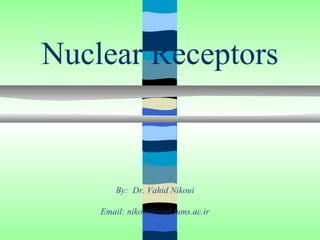Nuclear Receptors
- 1. Nuclear Receptors By: Dr. Vahid Nikoui Email: nikoui@razi.tums.ac.ir
- 2. ïŪ Regulate gene expression ïŪ Ligands pass the cell membrane by simple diffusion ïŪ Receptors in the cytoplasm or in the nucleus
- 3. Small molecule coactivators of transcription Steroids
- 4. Small molecule coactivators of transcription Lipid-Soluble Vitamins & Thyroid Hormone Vitamin A Thyroid Hormone
- 5. Nuclear receptor ligands are structurally diverse ïŪ Steroids â Estrogen (ER Îą,Îē) â Progesterone (PR) â Androgen (AR) ïŪ Non-steroidal lipophilic hormones â 1, 25-(OH)2-vitamin D3 (VDR) â All- trans-retinoic acid (RAR Îą,Îē, Îģ) â 9-cis-retinoic acid (RXR Îą,Îē, Îģ) â Fatty acids (PPAR Îą,Îē, Îģ) â Thyroid hormone (TR Îą,Îē) ïŪ Orphans (No ligand or ligand unknown)
- 6. Steroid hormone receptors
- 7. Action of Steroid Hormones versus Peptide Hormones Peptide Hormones Steroids Half-life in circulation short long Speed of action fast slow Duration of effect short long Location of receptor membrane inside Post-receptor regulation high low Signal amplification high low
- 9. Steroid Receptor Action Roles of Heat Shock Proteins and HREs hsp90 hsp70 H hsp70 H H R hsp56 dimerize H H P? H H Gene Transcription HRE target gene 5â flanking region
- 12. Nuclear hormone receptor: domain structure Zinc finger DNA binding domainâĶ inserts into major groove of DNA
- 14. Role of Phosphorylation in Steroid Receptor Activation 8-bromo cyclic AMP PKA? + Phosphate hypervariable DBD HBD transcription
- 16. T3 HORMONE VITAMIN D3 ALL-TRANS RETINOIC ACID 9-CIS RETINOIC ACID
- 19. Thyroid Hormone Receptors
- 25. THANK YOU !
Editor's Notes
- 3
- 8

























